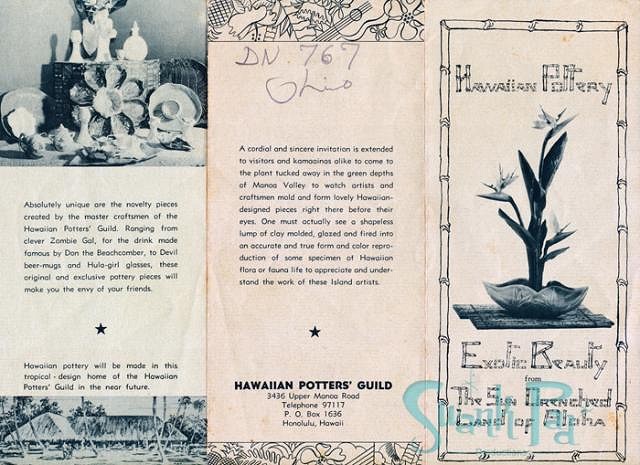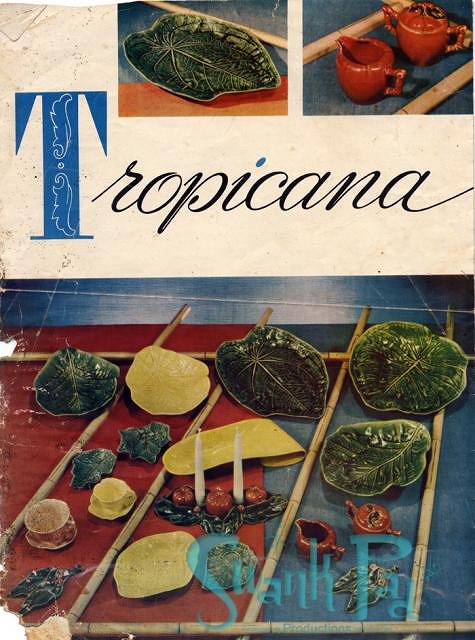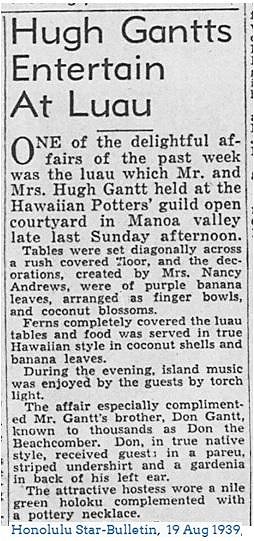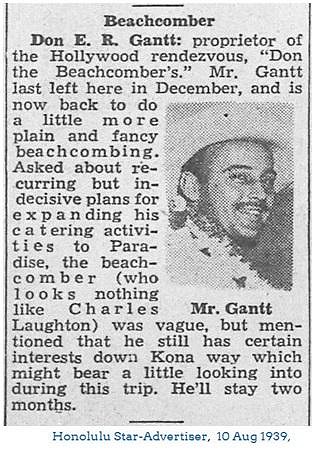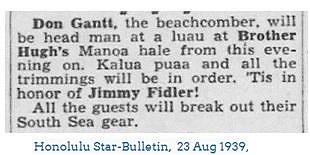Tiki Central / General Tiki
Origin of the Scorpion Bowl Cocktail
Pages: 1 5 replies
|
S
Swanky
Posted
posted
on
Wed, Oct 23, 2019 5:39 AM
Dave Wondrich does a great job uncovering the roots of the TV Scorpion recipe. Article HERE. I had dug up a good bit about Hugh and Lita Gantt's Hawaiian Pottery guild and even some current Hawaiian researchers looking into it. I knew where it was going when I hit that text.
I also had this article coutesy of Mike Skinner which he seems to be referencing. Other articles show Donn had recently arrived back on Hawaii in August 10th, staying 2 months.
Dave also muses that Vic and Donn may have been collaborating, but it would have been more likely that Vic was looking for a financial partner in Hugh, who had the money in the Gantt family. It wasn't too much earlier that Donn sold Vic $800 worth of decor to transform Hinky Dinks into Trader Vic's. The extent of that empire was not in anyone's minds. So Vic was just a friendly contemporary Donn and perhaps Hugh had done business with. He didn't even merit mention in the luau. Another luau at Hugh's place just 4 days later, with Donn in attendance, was specifically referenced to celebrate a certain visitor.
So Hugh served Vic a Scorpion. Then Vic put it on his menu... Was that the beginning of the rivalry? That rotten stinker!
[ Edited by: Swanky 2019-10-24 11:01 ] |
|
M
MadDogMike
Posted
posted
on
Wed, Oct 23, 2019 7:28 AM
Great info Swanky! Thanks Here's the text to that article in case the link disappears later: Unlike with most classic cocktails, whose origins tend to be at least murky and often completely untraceable, thanks to the research of Jeff “Beachbum” Berry and a few others we generally have a pretty good handle on where the tiki elite came from. The Jungle Bird, for instance, stems from the Aviary Bar at the Kuala Lumpur Hilton, sometime between 1972 and 1982. The Zombie and the Mai Tai have both been argued to death, but the consensus is that the former was invented in Hollywood, California, by tiki god Ernest Raymond Beaumont Gantt, alias Don the Beachcomber, while the latter was the creation of Gantt’s imitator, competitor and, ultimately, fellow tiki god, Victor “Trader Vic” Bergeron, up the coast in Oakland. The Scorpion Bowl is another that has been chalked up to Vic: in its perfected form, half a bottle’s worth of booze mingled with various fruit juices and whatnot in a gaudily-painted ceramic vessel supported by three kneeling hula girls (also in ceramic) with four long straws jutting over the edges and a gardenia floating placidly in the middle. It was Vic’s first breakout drink; the first of his specialties to be swiped by other bars. As Vic wrote in his 1946 Trader Vic’s Book of Food and Drink, he was inspired to create this four-person care-killer by “a very beautiful form of gentle anesthesia” that was served to him “at a luau up in Manoa Valley in Honolulu.” The affair as he describes it is straight out of an Elvis movie: an old kama’aina family (that is, not indigenous, but born in Hawaii or long settled there); an open-air shed surrounded by a “gorgeous tropical garden” with flowers of every color and fragrance—pikake (Arabian jasmine), frangipani, tuberose, wild ginger—and carpeted with banana leaves and ti fronds (the things that supply the “grass” in grass skirts); a warm rain drumming counterpoint on the tin roof to the Hawaiian band’s soft ukuleles and steel guitars. There were ti-leaves and flowers on the tables as well, and, one presumes, the usual roast pork, poi and other island staples: Vic doesn’t mention the food. Instead, he talks of the “tremendous Chinese earthen crock which easily held twenty gallons” that was full of “Honolulu’s famous Scorpion, a drink which does not shilly-shally or mess around in getting you under way.” Before giving his Scorpion recipe, he adds, “as originally made, with okolehao and rum, the Scorpion is at its best, but the following formula is practically as good an infusion as the original.” His recipe keeps the original’s rum, but instead of the generally unavailable okolehao—Hawaii’s native spirit, distilled wholly or partly from the starchy, tuberous stem of the ti plant—it uses a mix of gin, brandy and white wine, plus orange and lemon juices, mint and orgeat (almond) syrup. And, of course, gardenias. From this “practically as good” version we get all the subsequent Scorpion Bowls, including Vic’s own later version, where he used pisco instead of the gin. But rather than look at all those later bowls of sweet, flower-bedecked communal intoxication, I’d much rather go in the other direction; go back and examine the original, Hawaiian drink upon which Vic claimed to have based his. After all, it has always been a criticism leveled at tiki drinks that they’re not in fact Polynesian at all, but are just Caribbean rum punches in South Seas drag. But, if Vic is to be believed, here behind one of the great tiki classics we have an actual Hawaiian drink. The only problem is that there’s never been any evidence that such a drink actually existed. You can search for an earlier account of the Scorpion than Vic’s through all the bar books you want, all the letters, diaries and memoirs of travelers in Hawaii in the 1930s and during the war years that followed, all the menus from Hawaiian bars, all the old-timers’ reminiscences. What you’ll find is ’a’ohe mea, as they say in Hawaiian. Not a thing. That, coupled with the fact that Vic was always a fine storyteller—if you can find a copy, his loose and amusing 1973 memoir, Frankly Speaking, is well worth a read—has generally led investigators, myself included, to the conclusion that all that luau stuff was just window dressing; that the Scorpion in Vic’s book was purely his own. Waikiki Willie would have begged to differ. “Waikiki Willie” was the moniker atop the gossip column the old Honolulu Star-Bulletin used to run back in the years just before Pearl Harbor. Written by one Francis T. King, island-born and well-connected (“Waikiki Willie sees all, hears all, tells part of it” was his motto), the column covered the unique, relaxed and multi-ethnic cocktail circuit Honolulu boasted of in those days, when it was still a relatively small town of some 170,000 people and very far from America. Until very recently, if you wanted to see what Willie had to say about the Scorpion or anything else, you would have had to spend hours and hours at the Honolulu Public Library, slowly spooling through microfilm, and even then you were likely to run out of time and patience before you found him. But now you can search the Star-Bulletin by keywords, for a fee, at Newspapers.com, and with luck and patience (some things don’t change) you can find Willie announcing that, for the farewell party being planned for a sporty malihini—that is, stranger or tourist—from Denver, “Panama Dave is fixing some of those only too well known ‘scorpions,’ three gallons of them.” That was on August, 3, 1938. You can find a few other references, too, some from Willie, some elsewhere. (The earliest of them is from another gossip columnist, Ray Coll, Jr., who closed his May 28, 1937, column in the Honolulu Advertiser with “Excuse, please, while we go brew a scorpion.”) And if you’re really, really lucky, you can even turn up Jane Howard’s “Waikiki Promenade” column, also in the Advertiser, from August 6, 1938, where she explains exactly what that Scorpion was that Waikiki Willie was talking about three days earlier: “To make a batch of Scorpions the chief requirements are a gallon of okolehao and patience. Pouring the oke into a crock, you add a half cup of sugar, two bunches of mint, six oranges and four lemons (rinds and all) and put the resulting mess away for a few days…. [A]fter three or four days, strain the beverage through cheesecloth, pour it over a cake of ice into a punchbowl and serve it to your guests.” Simple enough, and with the earthy, almost raw-potato tang of okolehao, no doubt tasty enough; next time I can get my hands on a gallon of the stuff I’ll give it a spin. Not only does Howard give us the recipe, she also explains why it never made it into the drink books: it wasn’t a universal Hawaiian or even Honolulu favorite, but rather it was only popular “in certain circles.” She doesn’t go on to tell us who made up those circles, but it’s easy enough to piece together. The fact that “Panama Dave” was a Scorpion specialist is a big, fat clue. Panama Dave was otherwise known as Charles Batiste, and he was one of the original “beach boys”: the crew of native Hawaiians and kama’aina who spent their days on Waikiki beach between the Moana and Royal Hawaiian hotels—the two big hotels on the beach then—and surfed, swam, paddled outriggers, played ukuleles, told Hawaiian stories and basically modeled Hawaiian life and culture for the tourists. They made their money by paddling the malihini around in the canoes or by giving lessons in surfing or ukulele-strumming or any of the rest. With the legendary Olympic swimmer and surf god Duke Kahanamoku as their (unpaid) leader, they were the bridge between Hawaiian culture and America—without them, there would have been no surfing in California, no Beach Boys with capital Bs, none of that. Their way was informal—they took the tourists who were interested in what they had to offer, a group that included movie stars such as Douglas Fairbanks, singers such as Bing Crosby, industrialists, socialites, whoever, and folded them into the loose, perpetual party that was beach life. If you fit in, you became one of the group. (Conversely, through their new friends a number of the beach boys, from Duke on down, were recruited to make Hawaiian records and appear in Hollywood films.) So given that there was an actual, Honolulu Scorpion, then perhaps Vic wasn’t bullshitting about the Manoa Valley luau where he was introduced to it. If it took place, it would have had to be before October, 1939, when Vic’s Scorpion is named in an article about his drinks. The Honolulu papers come in handy here, as well. One thing newspapers used to do, particularly in the smaller cities, is print a record of arriving and departing steamship passengers. From those columns, plus American immigration records (Hawaii was a territory, not a state then), it’s clear that Trader Vic didn’t set foot in Hawaii until August, 1939. That was a full year after he turned Hinky Dinks, his tiny, self-built hamburger shack on San Pablo Avenue in north Oakland, into Trader Vic’s, specializing in exotic beverages from the Tropics, Chinese food and South Seas décor. To prepare for that transformation, he had spent a few weeks in early 1938 traveling to New Orleans and Havana, and a week hanging around Don the Beachcomber in Hollywood watching how a “Tropical” bar was run, but this was his first visit to an actual Pacific island. Vic arrived in Honolulu on August 10, one of 17 passengers on the hideously expensive Honolulu Clipper, flying overnight from San Francisco. He left on the 21, on the Matson steamship line’s Matsonia. Those dates are important because of something else the Honolulu papers covered: luaus. Any big luau, no matter if it was open to the public or an entirely private affair, was worth a few lines in the society pages. In the eleven days that Vic was in town, the paper covered a number of the things, but only one was held in the Manoa Valley, a sparsely-populated area with a road that ran up into the steep hills north of Waikiki. That Luau was hosted by the Hawaiian Potters Guild on the afternoon of Sunday, August 13, at its compound on upper Manoa Road. “Tables were set diagonally across a rush-covered floor” the reporter for the Star-Bulletin wrote, “and the decorations…were of purple banana leaves, arranged as finger bowls, and coconut blossoms. Ferns completely covered the luau tables and food was served in true Hawaiian style in coconut shells and banana leaves. During the evening, island music was enjoyed by the guests by torchlight.” Well, OK. That would be close enough for me. But in 1947, in a promotional mailer for his Oakland joint, Vic elaborated a little more on the Scorpion, claiming that it was “originated after a fashion at a Luau given by the Hawaiian Potters Guild some years ago.” Bingo. And yes, the Scorpion was “a beautiful potion of Okolehau [sic],” gin [not rum], mint and half a dozen different fruits all blended together and chilled. And also yes, it came in a large bowl “in which we all dipped our coconut cups.” In other words, Vic told the truth. There was a luau, they served Scorpions, he was there. Only he didn’t tell the truth; not all of it, anyway. One can lie by omission just as much as one can by commission, and Mr. Bergeron was hiding something big about said luau. In his 1946 book, he said that the attendees were “guests of an old kamaaina family,” and in the 1947 mailer he added that the luau “was held to celebrate Kahuna or some damn thing.” Now, Vic’s Hawaiian theology was poor: a “kahuna”—there is not just one—is not a god, but rather a priest or wizard. And while the person the luau was celebrating was definitely a wizard of some sort, he wasn’t Hawaiian. He was born instead in Tiger Prairie, Texas, a bit of unincorporated nothing southeast of Mexia, lived in Hollywood, California, and was a citizen of the world, or at least all of the parts of it where palm trees dropped coconuts on sandy beaches; where trade winds blew off the midday heat; where a glug of local rum, a healthy pinch of sugar and a couple of limes were all you needed to round the edges off a world that grew them sharp. The Potters Guild luau was hosted, you see, by its new president, Hugh H. Gantt, a fairly recent arrival on the island, in honor of his little brother, Ernest—the one everybody called Don. I don’t know why Trader Vic hid that information. The year before, the Beachcomber had sold the Trader a bunch of items from the South Seas with which to replace the moose heads and snowshoes and other hunting and fishing paraphernalia with which Hinky Dinks was adorned, and Vic always acknowledged the early inspiration the Beachcomber had provided. Beyond that, though, he didn’t talk about the man much. On the other side, some of the Beachcomber’s employees recalled Vic as the annoying customer who wouldn’t leave; as the guy who hung against the ropes outside waiting on line to come back in every night. But the Beachcomber was as private and quiet in his opinions as the Trader was loud and public, and if Vic’s success galled him, he didn’t go around talking about it. It’s possible that Vic cut Don out of the picture because he essentially swiped the Scorpion from him, or at least lifted it from under his nose (who knows, Don could have even been the one who brewed that huge bowl of it) and made it famous and didn’t want to shadow it. (As for Don, a true original in everything he did, he would not, of course. have wanted anything to do with the drink once it became associated with someone else.) But I wonder if there’s something else behind this weird omission. Don had begun making frequent visits to Hawaii by 1936, not long after he opened his Hollywood bar, and by 1937 he was actively looking for a spot where he could build a Honolulu outpost. By October of that year, he had settled on a location, just west of Waikiki. Things got serious; plans were drawn up, money raised, and so forth, but then, in June, 1938, the deal fell through due to neighborhood resistance. He still kept looking, though. In August, 1940, Trader Vic announced that in partnership with San Francisco financier Granville Abbott and a more-or-less local, Waikiki beach bum Carlton “Dago” Wines (a high-society dropout), he was going to build a Honolulu Trader Vic’s. That actually came to fruition, opening at the end of the year. What makes me wonder is the fact that, back in 1939, Don stepped off the Matson Lurline on August 9, a day before Vic landed, and flew out to Los Angeles on the 20, the day before Vic left. That timing seems awfully coincidental. Is it possible that they were discussing a partnership? That Hawaii might have boasted of a restaurant run by the two great totems of tiki? The fact that he screwed Don by going ahead with someone else might explain Vic’s silence, and perhaps Don’s, too. In any case, things worked out in the end: Vic sold his share of the Honolulu operation after a few months because he didn’t like the travel involved. After the war, which Don spent in the Air Corps building and running officers’ clubs, first all over the West and then in Europe (Vic, who had a wooden leg, did not serve), he moved to Hawaii and spent the rest of his days there, running fabulous bars and living the good life. As far as I can tell, he never did make Scorpions, though." |
|
A
arriano
Posted
posted
on
Thu, Oct 24, 2019 10:33 AM
Where does Dave Wondich say Donn wasn't there? I've read the article twice and I don't see where it says that. In fact, I'm seeing just the opposite:
|
|
S
Swanky
Posted
posted
on
Thu, Oct 24, 2019 11:00 AM
Ah, you're right. I mis-read the part about Donn left on the 20th. I don't have a passenger list of Donn departing (or arriving for that matter). I'll amend my first post. [ Edited by: Swanky 2019-10-24 11:07 ] |
|
UB
Unga Bunga
Posted
posted
on
Thu, Oct 24, 2019 11:58 AM
|
|
M

mikehooker
Posted
posted
on
Fri, Oct 25, 2019 4:25 PM
Great research and article! |
Pages: 1 5 replies

